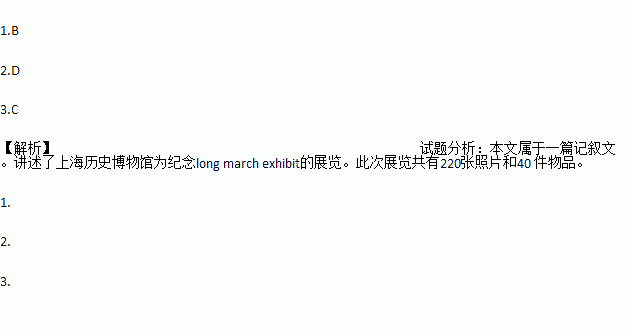题目内容
Events Long March exhibit
The Shanghai History Museum is putting on an exhibition to mark the 60th anniversary of the Long March. On show are more than 220 photos and 40 items that explain with pictures how the communist Red Army drew back from its besieged ( 被围困的) bases in Jiangxi Province and fought its way to northern Shanxi province in the mid-1930s. Explanations are all in Chinese. The show will end on November 20.
Time: 10:00 am—4:00 pm.
Address: 1286 Hongqiao Road
Admission: 8 yuan for Chinese/ 15 yuan for foreigners
Thai elephants
Eight elephants from Thailand are entertaining visitors at Changfeng Park by riding bikes, playing basketball, balancing on a beam, dancing and blowing a mouth-organ. People are encouraged to have a tug-of-war (拔河比赛) with the animals or lie on the ground and have the elephants walk over them. The elephants give three shows a day at 9:30 am, 3:30 pm and 8:00 pm and there is an additional show at 1:30 pm at weekends. The show will end on November 15.Address: 189 Daduhe Road
Admission: 30-40 yuan
Dancing dolphins
Dolphins jumping from the water to touch a ball, swaying their bodies to music, kissing people and solving math by tapping their tails have made the dolphinarium in Peace Park an attraction for children. Seals and sea lions also perform.
Hours: 10:30 am, 4:00 pm, and 7:30 pm
Admission: 20 yuan for adults and 10 yuan for children.
1.If you go to visit the Long March exhibit with an Australian, how much will you pay altogether for the admission?
A. 16 yuan B. 20 yuan
C. 30 yuan D. 23yuan
2.At the exhibition, you will see ________.
A. many articles written by famous writers
B. many things left by the Red Army
C. books on the Long March
D. many photos and pictures about the Long Match.
3.Which of the following is NOT done by the Thai elephants?
A. Doing math B. Blowing a mouth-organ
C. Riding bicycles. D. Having a tug-of-war with people.
 课课通课程标准思维方法与能力训练系列答案
课课通课程标准思维方法与能力训练系列答案

 the human body. __ 2._____.
the human body. __ 2._____.